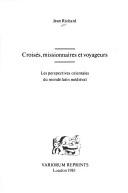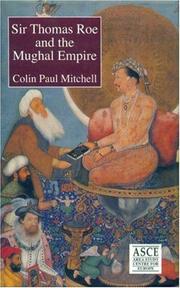| Listing 1 - 10 of 11 | << page >> |
Sort by
|
Multi
ISBN: 9780511978401 9781108073288 0511978405 Year: 2011 Publisher: Cambridge : Cambridge University Press,
Abstract | Keywords | Export | Availability | Bookmark
 Loading...
Loading...Choose an application
- Reference Manager
- EndNote
- RefWorks (Direct export to RefWorks)
The first English version of Bernier's 1670 work since its initial translation from the French in 1672, Irving Brock's 1826 edition vastly improved his predecessor's work. François Bernier (1625?-1688) trained as a physician at Montpellier and left France for Syria in 1654, travelling to Egypt and finally to India ('Hindustan'), where he spent twelve years as the court physician to the Great Mogul Aurangzeb. Celebrated and influential, his Travels shaped European opinions and knowledge of India. Brock provides a biography in his preface to Volume 1, where he also outlines the volumes' contents. Volume 1 narrates civil war, describes the government and finances of the court, and the army, and closes with detailed descriptions of Delhi and Agra. Including Brock's many interventions to relate the narrative to imperial Britain, this work will be of interest to scholars of post-colonialism, of early modern travel and of Asian and European encounters.
India --- Bernier, Francois, --- Mogul empire. --- Description and travel --- Mughal Empire.
Book
Abstract | Keywords | Export | Availability | Bookmark
 Loading...
Loading...Choose an application
- Reference Manager
- EndNote
- RefWorks (Direct export to RefWorks)
English literature --- English drama --- Aurangzeb, --- Drama. --- Mogul Empire --- Kings and rulers
Book
ISBN: 9789383243198 Year: 2017 Publisher: Mumbai Marg
Abstract | Keywords | Export | Availability | Bookmark
 Loading...
Loading...Choose an application
- Reference Manager
- EndNote
- RefWorks (Direct export to RefWorks)
"Set apart from the descriptive guides that exist on the subject, this book analyzes the meaning of the Qutb Complex's monuments and their afterlife from the fourteenth through the twenty-first centuries. The Qutb complex is one of Delhi's major tourist attractions and the Qutb Minar is often used as an iconic emblem representing the city. Yet aside from scholarly essays and largely descriptive books on the site, there has been little attempt to write an accessible analysis of the site's monuments, patrons, inscriptions and history. This book will examine not only the site as it was developed in the early Sultanate period, but also probe its life prior to the establishment of Muslim rule in the late-twelfth century and then again after the period of Sultanate patronage of the site up to the present. The aim of this volume is to prove that over time the complex remained considerably more significant in meaning than is generally believed. The surrounding urban area, including dargahs, temples, mosques, tombs and water sources, will be studied in terms of their relation to the core mosque and minaret. A comprehensive analysis of the interwoven histories of the Qutb Complex and its architecture, this book is both visually sumptuous and informative" -- editor
Religious architecture --- minarets --- mosques [buildings] --- archaeological sites --- Islamic Indian --- Delhi --- Monuments --- Architecture islamique --- Architecture moghole --- Kutb Minar (Delhi, India) --- Architecture, Mogul Empire --- Islamic architecture --- Pictorial works. --- religieuze architectuur
Multi
ISBN: 9780521870955 9780521691420 0521691427 052187095X 9780511818646 1316183688 131618319X 0511818645 Year: 2012 Volume: 5 Publisher: New York (N.Y.) Cambridge University Press
Abstract | Keywords | Export | Availability | Bookmark
 Loading...
Loading...Choose an application
- Reference Manager
- EndNote
- RefWorks (Direct export to RefWorks)
Between 1453 and 1526 Muslims founded three major states in the Mediterranean, Iran and South Asia: respectively the Ottoman, Safavid, and Mughal empires. By the early seventeenth century their descendants controlled territories that encompassed much of the Muslim world, stretching from the Balkans and North Africa to the Bay of Bengal and including a combined population of between 130 and 160 million people. This book is the first comparative study of the politics, religion, and culture of these three empires between 1300 and 1923. At the heart of the analysis is Islam, and how it impacted on the political and military structures, the economy, language, literature and religious traditions of these great empires. This original and sophisticated study provides an antidote to the modern view of Muslim societies by illustrating the complexity, humanity and vitality of these empires, empires that cannot be reduced simply to religious doctrine.
Iraq --- Mogul Empire --- Empire ottoman --- Empire moghol --- Mogul Empire. --- MUSLIM WORLD -- 930.3 --- History of Asia --- anno 800-1199 --- anno 1200-1799 --- India --- Iran --- Asian Turkey --- Turkey --- History --- Histoire --- Moghul Empire --- Mughal Empire --- Mugala Empire --- Ottoman Empire, 1288-1918 --- Mughal Empire.

ISBN: 0860781305 9780860781301 Year: 1983 Volume: CS182 Publisher: Aldershot (Hants): Variorum,
Abstract | Keywords | Export | Availability | Bookmark
 Loading...
Loading...Choose an application
- Reference Manager
- EndNote
- RefWorks (Direct export to RefWorks)
History of Europe --- History of Asia --- anno 1200-1499 --- S38/1314 --- S38/1305 --- Works not related to China and the Far East--Comparative religion: Christianity and other religions --- Works not related to China and the Far East--Islam --- Crusades. --- Voyages and travels. --- Geography, Medieval. --- Cyprus --- Mogul Empire --- Middle East --- History. --- Crusades --- Geography, Medieval --- Voyages and travels --- Journeys --- Travel books --- Travels --- Trips --- Geography --- Adventure and adventurers --- Travel --- Travelers --- Medieval geography --- Church history --- Middle Ages --- Chivalry --- Offprints --- 940.181 --- 940.181 Kruistochten --- Kruistochten --- -History --- History --- Cyprus - History --- Middle East - History --- Mogul Empire - - History --- -Crusades --- -Crusades. --- Mogul Empire -

ISBN: 9698551018 Year: 2000 Publisher: Karachi Area Study Centre for Europe
Abstract | Keywords | Export | Availability | Bookmark
 Loading...
Loading...Choose an application
- Reference Manager
- EndNote
- RefWorks (Direct export to RefWorks)
Ambassadors --- Roe, Thomas, --- Rhoe, Thomas, --- Roe, T. --- Row, Thomas, --- Rowe, Thomas, --- Great Britain --- Mogul Empire --- Moghul Empire --- Mughal Empire --- Mugala Empire --- Foreign relations --- History of Asia --- Roe, Thomas [Sir] --- South Asia
Book
ISBN: 9789004371095 9789004374997 900437499X 9004371095 Year: 2018 Publisher: Leiden, Boston: Brill,
Abstract | Keywords | Export | Availability | Bookmark
 Loading...
Loading...Choose an application
- Reference Manager
- EndNote
- RefWorks (Direct export to RefWorks)
In Mughal Occidentalism , Mika Natif elucidates the meaningful and complex ways in which Mughal artists engaged with European art and techniques from the 1580s-1630s. Using visual and textual sources, this book argues that artists repurposed Christian and Renaissance visual idioms to embody themes from classical Persian literature and represent Mughal policy, ideology and dynastic history. A reevaluation of illustrated manuscripts and album paintings incorporating landscape scenery, portraiture, and European objects demonstrates that the appropriation of European elements was highly motivated by Mughal concerns. This book aims to establish a better understanding of cross-cultural exchange from the Mughal perspective by emphasizing the agency of local artists active in the workshops of Emperors Akbar and Jahangir.
Iconography --- Mughal --- anno 1500-1599 --- anno 1600-1699 --- Europe --- India --- Peinture moghole --- Art --- Art, European --- Painting, Mogul Empire --- Influence européenne. --- Thèmes, motifs. --- Influence. --- European influences. --- Themes, motives. --- Painting, Mughal Empire
Multi
ISBN: 9781474460750 9781474460729 Year: 2022 Publisher: Edinburgh Edinburgh University Press
Abstract | Keywords | Export | Availability | Bookmark
 Loading...
Loading...Choose an application
- Reference Manager
- EndNote
- RefWorks (Direct export to RefWorks)
The architecture and monuments of Bayana in Rajasthan challenge the established view of the development of Muslim architecture and urban form in India. At the end of the 12th century, early conquerors took the mighty Hindu fort, building the first Muslim city below on virgin ground. They later reconfigured the fort and constructed another town within it. These two towns were the centre of an autonomous region during the 15th and 16th centuries. Going beyond a simple study of the historic, architectural and archaeological remains, this book takes on the wider issues of how far the artistic traditions of Bayana, which developed independently from those of Delhi, later influenced north Indian architecture. It shows how these traditions were the forerunners of the Mughal architectural style, which drew many of its features from innovations developed first in Bayana.
Architecture --- Archaeology and history --- Archaeology and history. --- Fortification --- Fortification. --- Inscriptions --- Inscriptions. --- Islamic architecture --- Islamic architecture. --- Monuments --- Monuments. --- Temples --- Temples. --- Tombs --- Tombs. --- Influence --- Bayana (India) --- India --- Mogul Empire. --- Rajasthan (India) --- History.
Book
ISBN: 9024721733 Year: 1979 Volume: vol 81 Publisher: 's-Gravenhage : Nijhoff,
Abstract | Keywords | Export | Availability | Bookmark
 Loading...
Loading...Choose an application
- Reference Manager
- EndNote
- RefWorks (Direct export to RefWorks)
History of the Netherlands
---
History of Asia
---
anno 1500-1599
---
India
---
Dutch
---
-954.025
---
910.4 <54>
---
297 <54>
---
Dutchmen (Dutch people)
---
Hollanders
---
Ethnology
---
History
---
Geschiedenis van India en Pakistan: Mogul-keizerrijk (1526-1707)
---
Ontdekkingsreizen. Reizen. Expedities. Reisverhalen--
Book
ISBN: 0701123095 0701123087 Year: 1978 Publisher: London Chatto & Windus
Abstract | Keywords | Export | Availability | Bookmark
 Loading...
Loading...Choose an application
- Reference Manager
- EndNote
- RefWorks (Direct export to RefWorks)
Illumination of books and manuscripts, Mogul --- Miniature painting, Mogul --- Miniature painting, Moghul Empire --- Miniature painting, Mughal Empire --- Miniature painting, Mughul Empire --- Moghul Empire miniature painting --- Mogul Empire miniature painting --- Mughal Empire miniature painting --- Mughul Empire miniature painting --- Illumination of books and manuscripts, Moghul Empire --- Illumination of books and manuscripts, Mughal Empire --- Illumination of books and manuscripts, Mughul Empire --- Moghul Empire illumination of books and manuscripts --- Mogul Empire illumination of books and manuscripts --- Mughal Empire illumination of books and manuscripts --- Mughul Empire illumination of books and manuscripts --- Painting --- India
| Listing 1 - 10 of 11 | << page >> |
Sort by
|

 Search
Search Feedback
Feedback About UniCat
About UniCat  Help
Help News
News